Today I’m chatting with Sam from Exekias Games about their board game Escape From Pompeii, which started life as a university project and has now grown into a live Kickstarter campaign that you can back right now. We dive into why board games make such brilliant educational tools, the challenges of distilling complex ancient history into accessible gameplay, and what it’s really like being a young designer navigating the world of crowdfunding for the first time. Sam’s honesty about the nerves, setbacks, and small victories that come with bringing a passion project to life makes for a really engaging read, and there are some great insights here for anyone interested in educational game design or the realities of indie publishing.
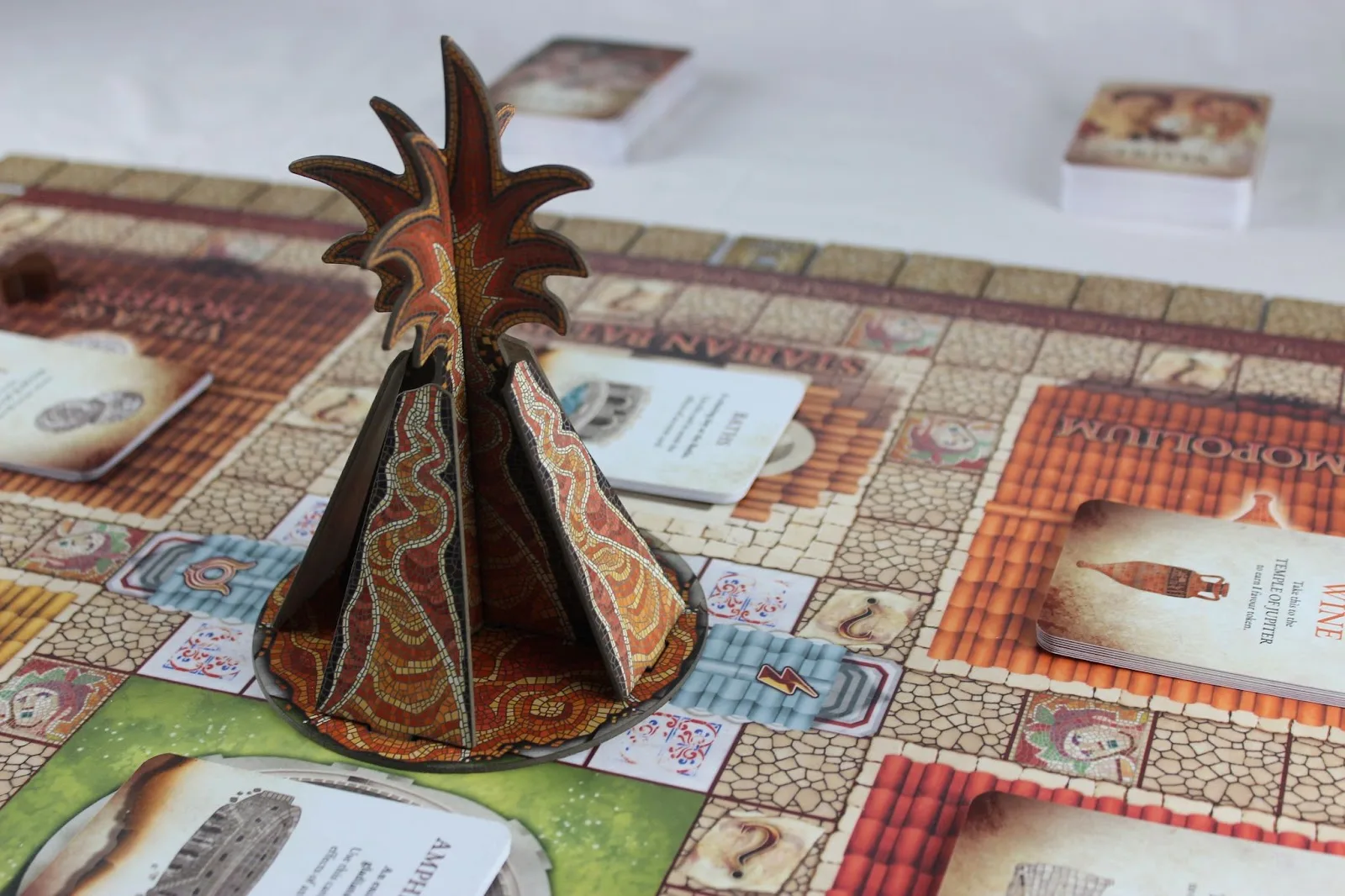
Joe: Heya, welcome to the What If blog! Can you let us know what brings you to the world of tabletop game design?
Exekias: Hi Joe! We actually started our board game as a university project. The goal was to create something that brought ancient history into the modern day and made it accessible. Both Fin and I love board games, so we decided to have a go at creating one set in the ancient world, which is how Escape From Pompeii was born. It’s taken a lot of work from there, and it was a big step from doing it as a group project to starting Exekias Games, but I think that starting point really informed our approach and pushed us to take it further.
Joe: Thanks Sam. If we go back to that initial project, what was it that you were being asked to do? And why the format of a board game?
Sam: The module was called ‘Applied Classics’ and we were asked to create something that allowed people to interact with the ancient world in some way. We chose a board game because board games are engaging, fun, and have huge potential for learning, especially for those who don’t do so well in a regular classroom environment. We also wanted to create something that people could really, physically interact with rather than anything virtual.
We chose a board game because board games are engaging, fun, and have huge potential for learning.
Joe: I use board games for learning in my day job; they’re such an interesting way of allowing a group to learn about a new topic. Why do you think they work so well?
Sam: There are a lot of reasons board games make such amazing educational tools. I think part of it is that they combat two of the big reasons a lot of people struggle at school: traditional classroom learning can be quite repetitive and can put a lot of pressure on students. Games break up that repetitiveness because they’re interactive – you have to be engaged because you’re making decisions and responding to other players, which means the gameplay is different every time. And they help to relieve the stress of expectations because at the very core of games is the fact that they are fun! Having fun is really important in combating stress levels and improving overall mental health. Learning through games can take the pressure off (unless you’re super competitive, in which case it can be a healthy environment for releasing stress, with a definitive end point: the end of the game).
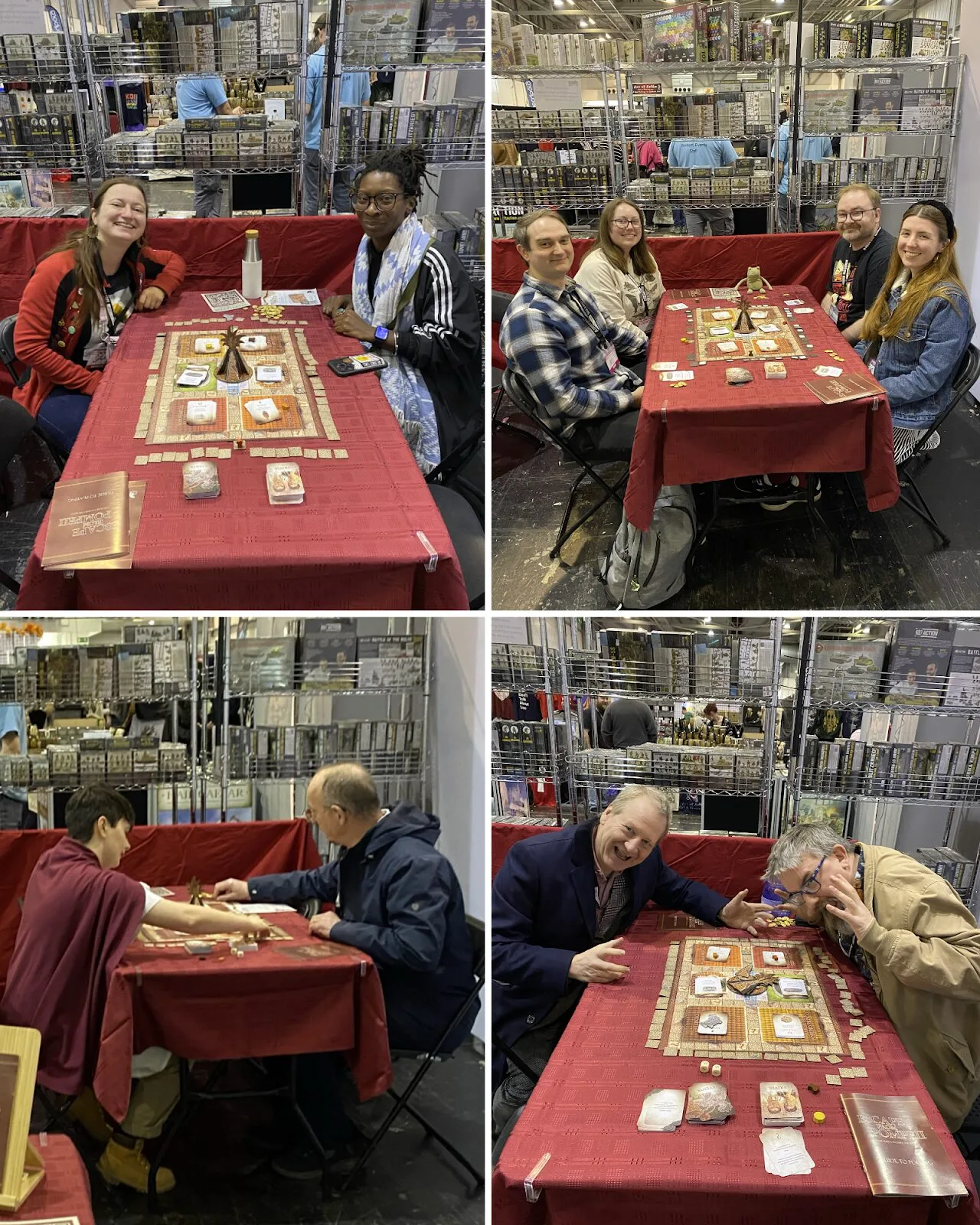
They’re also really effective for engaging your brain. Working out strategies, making decisions, and responding to the gameplay activates a lot of transferable critical thinking skills, whilst cooperative and competitive games both have links to social skills. Cooperative games are great for teambuilding and cooperation, whilst competitive games can improve players’ abilities to accept losses and setbacks, and empathise with those of other players.
Working out strategies, making decisions, and responding to the gameplay activates a lot of transferable critical thinking skills
Because games are so interactive and good at engaging your brain, they’re great for learning specific content as well. They put your brain in a state that’s brilliant for absorbing information and give you incentives to learn the information. Taking in information with context (e.g. the theme of the game) and applying it yourself (triggering an action or receiving some kind of bonus) helps to reinforce and retain the information you pick up.
Joe: I agree here. For my day job I’ve created a couple of games that help kids explore aspects of environmental science. Games are great for taking complex topics and modelling them in such a way that they become more accessible to all. Let’s explore your game, Escape from Pompeii, through this lens. What’s been the most challenging part of creating this game in terms of it fitting within that “educational” niche?
Sam: I think the hardest part was distilling down all the amazing and complex information there is about Pompeii and finding ways to get it into the game. In the game we’ve got real locations, resources based on common items, events linked to daily life and real things that happened, and trivia cards with lots of facts and information. The trouble is, I absolutely love ancient history and there are so many extra things I wanted to put in! We packed as much as we could into the game but obviously there’s a limit to what you can fit in without having a board the size of Pompeii and a stack of trivia cards as tall as Mount Vesuvius. (I think there will be a lot of expansion packs in our future!)
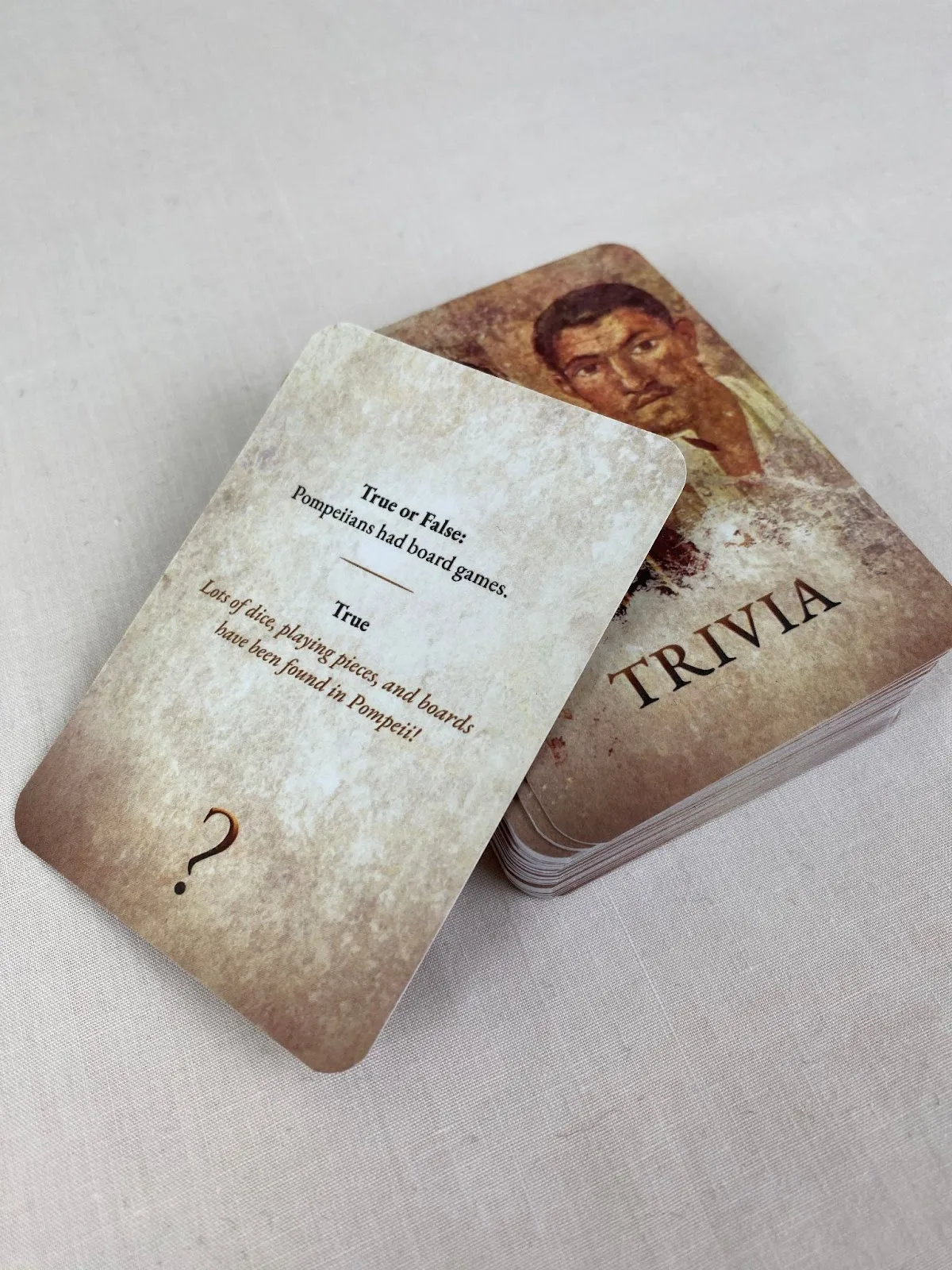
The most difficult thing was choosing which trivia questions and event cards would make it into the final game and how to word them to make them interesting and evenly balanced in difficulty. I couldn’t resist adding ‘fun facts’ to the bottom of the trivia cards just to get in a little extra bit of information or explanation.
The events are my favourite because they take things that happened and make them into a game mechanic. For example, there’s one that says “congratulations, you’ve come of age. You may now wear the toga virilis” which is a weird little bit of information about how when boys turned about 15 they’d be allowed to wear the fancier (and more uncomfortable) toga worn only by free male citizens. But it tells you something: you may not immediately know all the context from that one card, but you’ve picked up that clothes had ways of signifying things to Pompeiians, that there was a distinction between children and adults, and that being able to wear a ‘toga virilis’ was probably a good thing. And within the game, you pick up a ‘cloth’ card which is nice for your competitive side and helps to solidify this little bit of information in your brain.
Our goal is not to teach people absolutely everything but to give them the seeds of lots of big ideas and let them have a good time learning
Our goal is not to teach people absolutely everything but to give them the seeds of lots of big ideas and let them have a good time learning, so that if they choose to go and learn a bit more, it’s easier for them and they’re more confident in it.
Joe: Excellent. When I played, I loved the addition of the trivia, and those little details (temple names, etc.) that helped me understand the context. Can we explore a bit about your choices regarding publishing routes? You’re heading down the crowdfunding route – what’s the rationale there? Is it something you’ve got experience of, or is this going to be a new adventure?
Sam: This is a new adventure for us! So very exciting and also terrifying.
We looked at a couple of different routes for Escape From Pompeii. We got some funding from an enterprise competition to start Exekias Games up, and at one point we considered going with investors or publishers but our worry was that doing so would lose sight of our main goal, and become more profit-orientated. We obviously want to make enough money to make our games and support ourselves, but our mission is to inspire people to learn about the past and show them that they can enjoy doing so.
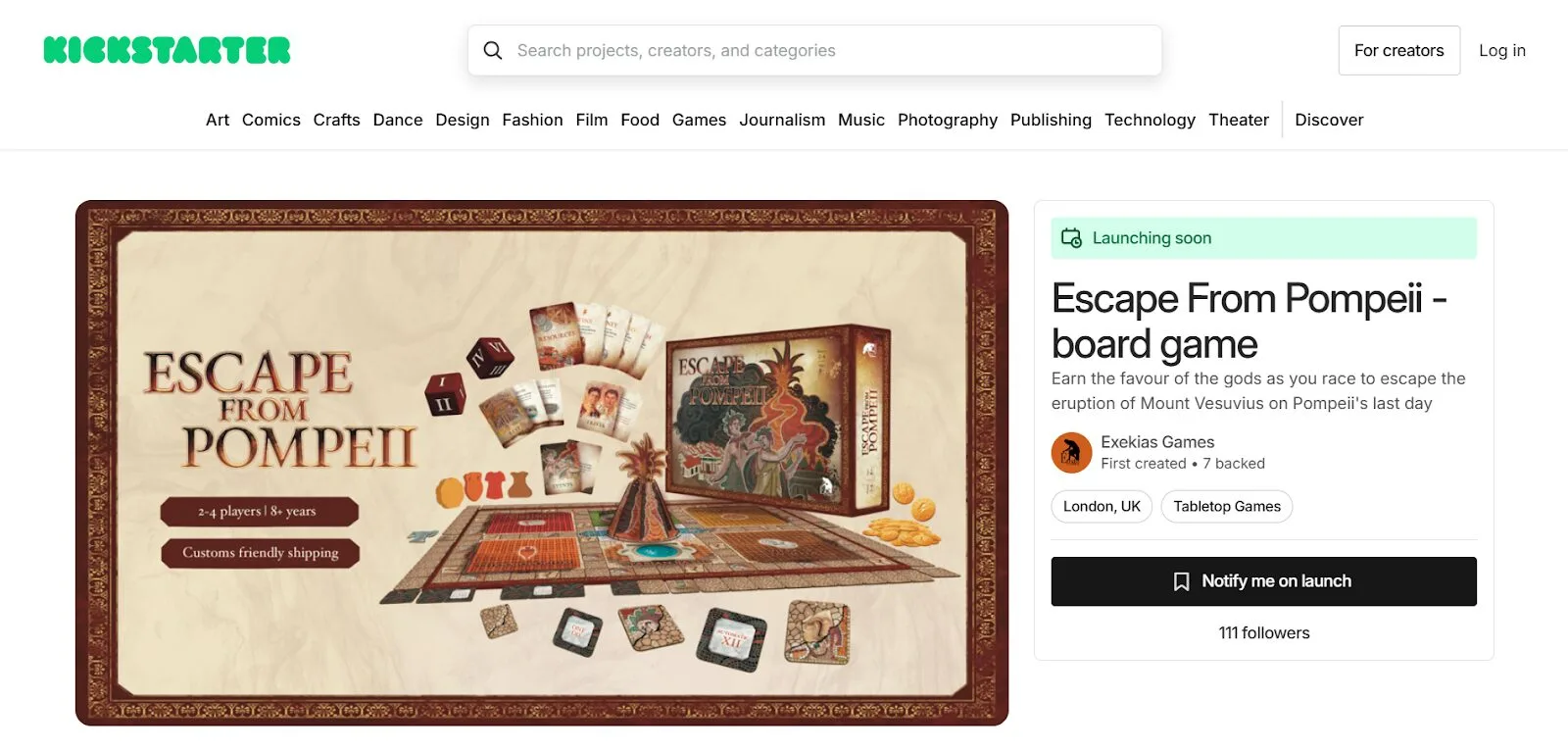
Crowdfunding gives us better control over the way we make our games, not compromising on the educational aspects or accurate representation of ancient cultures. It also allows us to be more involved in the communities we’re trying to serve and let them be more involved in the games we make. If a board gamer or a teacher or a parent has an idea or feedback, we want them to feel that they can reach out and let us know, and actually affect what we do.
We’re really grateful for all the support we’ve had, to make up for our lack of experience. It has been a huge learning curve (and will continue to be) but we have been able to rely on so many people throughout the journey. There are too many people to list here, but we’d like to shout out the BoardGameProtoHype community on Instagram, and all the advice and knowledge you guys have shared with us. Thanks for doing such an amazing job organising us all, Joe.
Joe: My pleasure. There’s some great knowledge and support from the community for all stages of the journey; it’s great that you’re finding it useful. Your rationale for the game’s launch sounds good – what you’re doing in terms of the educational piece is core to your game so finding routes that enable you to retain that is really important.
Part of what’s important about this blog is the experience of designers, the “what’s it like?”, “how are you feeling?” aspect of the process. So… how are you getting on?
Sam: We’re incredibly nervous! The trouble with trying to do something that we care so much about is that the make-or-break moments (like the Kickstarter launch) are so much scarier. We’ve spent the past two years putting so much work into this game – not only researching it, designing it, and testing it, but doing all the admin, marketing, and everything that goes into running a business. I’m only 22 right now, which means this game has been almost 10% of my life!
I’m only 22 right now, which means this game has been almost 10% of my life!
Logically, I know that if the Kickstarter doesn’t work out, it won’t be the end of things – we’ll learn from it, work on the things that need changing and try again. And even if nothing ever comes of it I’ve learnt so much from doing it, and enjoyed it so much, that it definitely won’t have been for nothing.
But to do something like this you have to care, and you have to hope it’ll work and put everything you’ve got into it. So, yeah, it’s pretty terrifying, but I’m proud of what we’ve made and all the things we’ve achieved so far, and I hope that everything we’ve done is enough to convince other people that Escape From Pompeii is worth caring about.
Joe: Thanks for your honesty there, Sam. It’s wonderful to see the care and love that’s going into this game. With these nerves, have you got any strategies for how to make sure they don’t become overwhelming? I assume working with Fin is an important part of that.
Sam: Yes, it’s definitely a massive weight off to be working with someone else on it. It’s always good to have someone else to brainstorm with, split the work with, and celebrate with. We had our first major setback about a month ago, and having someone to talk through it and commiserate with made it so much easier to handle. As odd as it sounds, I think that setback really helped my confidence in the project and our ability to work through difficult situations and move forwards.
I’ve also been really lucky to have such a great support network – I could not be more grateful for my family, friends, and my partner who have been so incredible throughout the journey. They are Escape From Pompeii’s number one fans – they tell everyone they know, listen to me talk about all the stuff I need to do, help out when I need some hand modelling for a trailer or a proofreader for the instructions. My dad even drove me up to Harrogate and wore a toga on our stall at AireCon for 3 days!
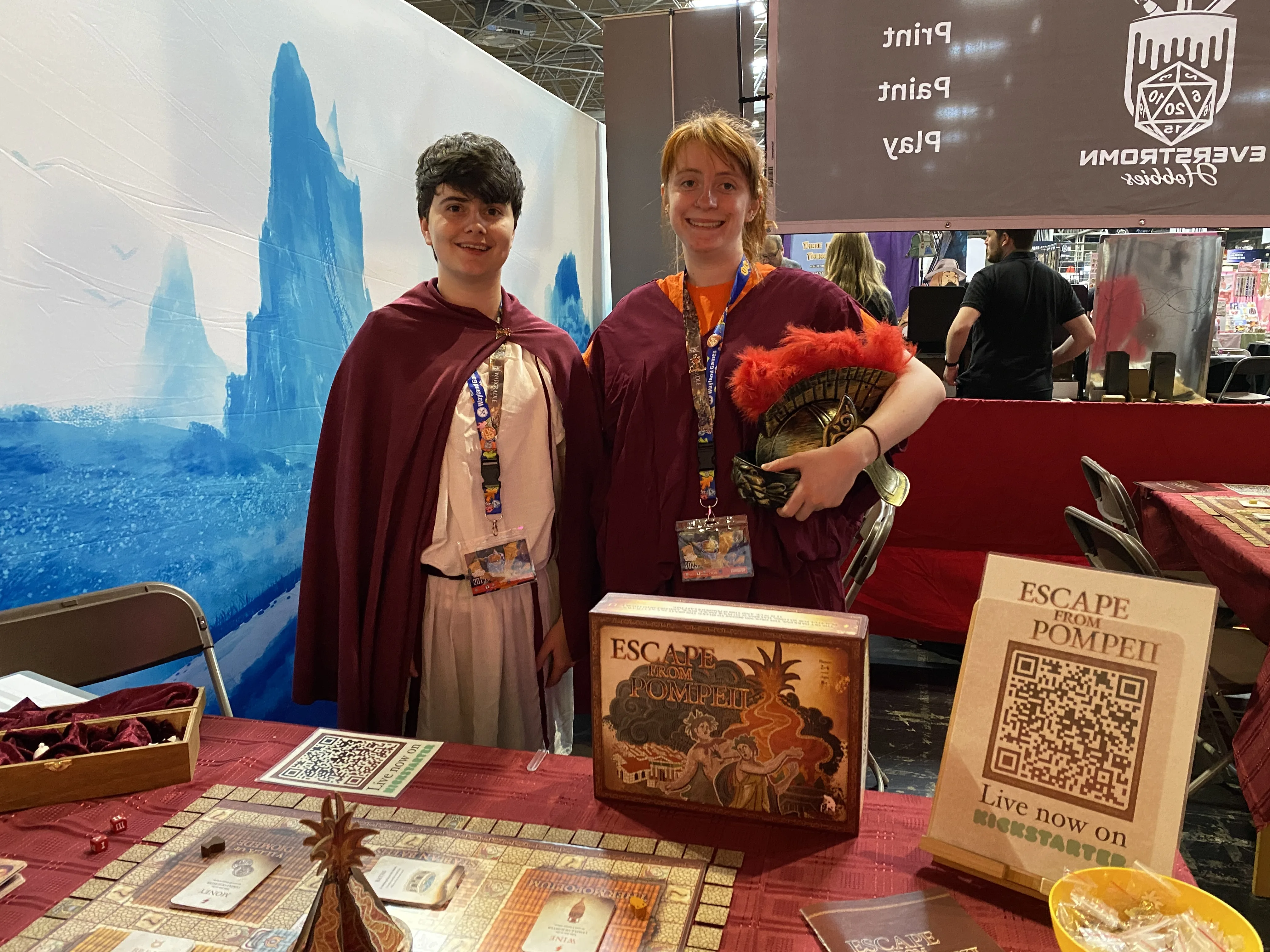
It’s so tempting to never stop when you’re working for yourself – I could just get one more thing done if I worked until 10pm or ate lunch in front of my computer – but having those breaks and some wind-down time in the evenings is so important for not drowning in your to-do list and worries. I have Instagram set to lock at 8pm on my phone so that I can’t keep looking at game-related stuff and thinking about all the things I have to do!
Joe: This is important advice – especially the bit about giving yourself a break. Can you let us know a bit about your setback?
Sam: Sure. We had originally planned to use some photos of real Pompeiian wall paintings within the game to show how amazing they are and strengthen the immersive and ‘real’ feel of the game. However, about a month ago we discovered that any photos or videos of Italian archaeological sites (even photos that are supposed to be under the Creative Commons licence or ones that you’ve taken yourself) are subject to a fee to the Italian government. So using these photos would put our manufacturing cost up by almost 30%. That meant we either had to massively increase the sale price or take the photos out.
It was a heartbreaking moment because we’d been so excited about using these real photos to show people how amazing Pompeii’s art is but we just couldn’t justify raising the price so much when our mission is to make the ancient world accessible. So instead, we decided to pay our designer (the brilliant Rob Ingle) to recreate the images in the amazing mosaic style he’d used for the rest of the game. It meant rearranging our budget a little to find the money for the new art, and it was our first real costly mistake, but in some ways I’m glad that this was our biggest mistake so far. It was hard and it cost us some money, but it could have been a lot worse. The fact that we adapted and didn’t crumble at the first big hurdle gives me more confidence in our ability to deal with difficult situations and see this project through.
And actually, the mosaic art Rob did looks absolutely fantastic! It fits in better with the rest of the artwork and still portrays the images we’d originally wanted. I think Terentius Neo and his wife (the real people in the image on the back of the trivia cards) would be thrilled with their new mosaic portrait.
Joe: That’s wild that you can’t use your own photos! But you’re right, Rob’s artwork has turned out lovely. Let’s round up by talking a little bit about the game, Escape from Pompeii. What’s the elevator pitch?
Sam: Pompeii is a vibrant, multicultural port town! The only problem is, it’s 79 CE, and this is Pompeii’s last day. The ground begins to shake, the sky turns black, and, for the first time in known history, Mount Vesuvius awakens.
Earn the favour of the gods by taking resources to their temples, manipulate the destruction of the city, and escape before it’s too late.
After each turn, players must turn over a tile. These can grant bonuses or consequences, or may be placed onto the board to crack one square into two. Players must adapt to this ever-changing board, using event and trivia cards to their advantage, and work out the best course of action as the clock ticks down. When the last tile is turned, Vesuvius erupts.
Joe: Thanks Sam – I’m looking forward to your Kickstarter. How can people support you and your game?
Sam: You can find the Kickstarter page here, and if you’d like to know more about what’s going on behind the scenes you can follow us on Instagram @exekiasgamesltd (we do also have a Facebook page and TikTok but I’m not as good at keeping those up to date!), or sign up to our mailing list here.
Thanks so much for having me, Joe!
Huge thanks to Sam for such an open and insightful chat about the journey from university project to live Kickstarter campaign. It’s brilliant to see designers who are so passionate about making learning accessible and fun, and I’m genuinely excited to see where Exekias Games goes next.
If you’re interested in educational games, ancient history, or just want to support some brilliant young designers, definitely check out Escape From Pompeii on Kickstarter. And if you’re a designer yourself, there’s loads to learn from Sam’s honest reflections on the ups and downs of bringing a game to market.


